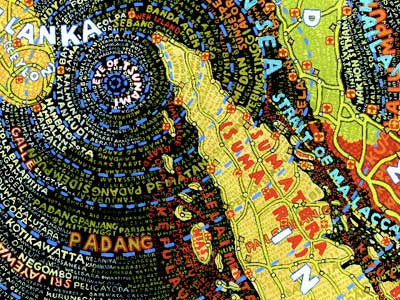What is this?
This is a copy of the presentation I gave today for my peers in the MA Design for Communication class. It uses a very new and innovative technique that I learnt recently from Liana. It is very simple to use, yet looks dynamic and very exciting. It doesn't present slides in linear order like PowerPoint. It's more user-oriented and interactive. Think about it as a big canvas when you can zoom in and out on different object.








How to view the presentation?
There are two methods you can use to view the presentation. Whichever you choose, open the presentation in the full-screen mode first by clicking on the button in the bottom right corner of the window.
Then, (1) simply press the 'play' button in order to process with the presentation in order we viewed it in the classroom. But remember, the presentation was interactive and viewers could choose the places they wanted to visit first on the map of the world.
Therefore, I would recommend that you view the presentation in the order of your individual choice (2). It's like a journey around the world! You can zoom in on any object (picture, text, frame) by clicking on it. Zoom out by pressing the 'space' button on your keyboard. Be adventurous and explore. I am sure you will have a lot of fun with it.
The word of introduction before you start exploring
I chose ethnic masks as a subject of my presentation because I am very interested in original and 'pure' culture. I am attracted to 'pure' custom, tribal traditions, cultures that evolved in isolation from Western influences.
And there is something incredibly mysterious and enigmatic about masks. They are used for protection from real and imagined dangers, for concealment, performance or amusement.
Masks have been used since antiquity for both ceremonial and practical purposes. They are usually worn on the face, although they may also be positioned for effect elsewhere on the wearer's body, so in parts of Australia giant totem masks cover the body, whilst Inuit women use finger masks during storytelling and dancing.
Throughout the world masks are used for their expressive power as a feature of masked performance - both ritually and in various theatre traditions. Masks are also a familiar and vivid element in many folk and traditional pageants ceremonies, rituals and festivals, and are often of an ancient origin. The function of the masks may be magical or religious; they may appear in rites of passage or as a make-up for a form of theatre. Equally masks may disguise a penitent or preside over important ceremonies; they may help mediate with spirits, or offer a protective role to the society who utilizes their powers.
Throughout the world masks are used for their expressive power as a feature of masked performance - both ritually and in various theatre traditions. Masks are also a familiar and vivid element in many folk and traditional pageants ceremonies, rituals and festivals, and are often of an ancient origin. The function of the masks may be magical or religious; they may appear in rites of passage or as a make-up for a form of theatre. Equally masks may disguise a penitent or preside over important ceremonies; they may help mediate with spirits, or offer a protective role to the society who utilizes their powers.
The presentation is also available online at:
My collection
Finally, this is a pick from my personal collection. They are not the original tribal artworks. I buy them on ebay. They were probably produced as souvenirs for tourists, but still, I find them fascinating and inspiring.


















